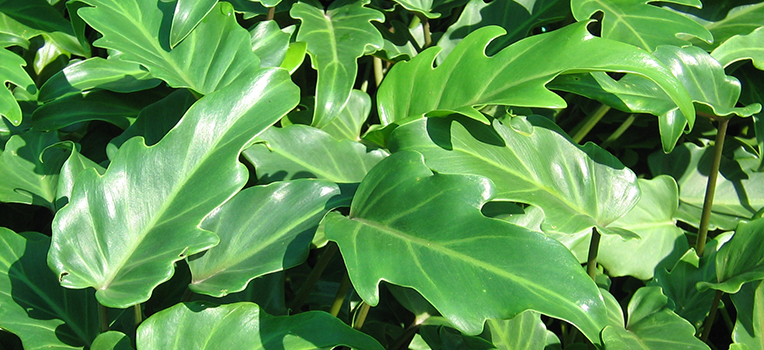Plants with Big Leaves
Leaves are the plant’s powerhouse. They capture sunlight and using chlorophyll, the enzyme that makes leaves green, turn it into sugars to fuel growth. The transformation is known as photosynthesis and it is a fundamental part of life on earth.
Although all plants carry out photosynthesis a myriad of leaf types have evolved. Some are big, some are small, some shiny, some furry, some sharp and prickly while others are soft and felty.
The size, shape and texture of a plant’s leaves reveals a lot about its natural habitat. Among garden plants, masses of small leaves tend to be the norm. Many small leaves means a plant can generate lots of energy but is not investing too much in each leaf. As well, small leaves are less likely to be damaged by wind or rain.
But some leaves ignore what looks like the sensible approach to photosynthesis instead opting to grow large and lush. These leaves are usually found on plants that have evolved to grow in a shaded location such as a forest. In low light, the larger leaf surface can capture more sunlight.
The largest leaf of any plant belongs to a water lily from the Amazon. Victoria amazonica was named in honour of Queen Victoria. Its leaves can grow up to 3m in diameter, float like large, round rafts on the water, and are strong enough to support the weight of a child. These amazing lilies are not for the home garden but can be found in botanic gardens around the world. The Adelaide Botanic Gardens has a glasshouse dedicated to this giant lily. Make sure you visit it if you are in Adelaide!
Think big
Gardeners can benefit from natural plant adaptations by selecting large, leafy varieties to make the most of shaded gardens, sheltered patios or verandahs, or to grow indoors. They also make a bold statement and add a lush look to the garden.
To get the most from large leaves, plant a mix of shrubs and perennials to provide a range of leaf colours, shapes and textures. Here are three top choices for big leaf colour and variety. All grow in low light.
Elephant’s ears (Alocasia and Colocasia spp.) These heart-leafed perennials are a relative of the taro and live up to their common name of elephant’s ears! Some have bold green leaves while others are almost black (‘Black Amazon’). They grow 1m or more in height and prefer part shade. Whether in the ground or in a container, don’t let them dry out. Moist but well-drained soil is ideal.
Fiddle-leaf fig (Ficus lyrata) This handsome large-leaved fig has dark green leaves that are indeed fiddle shaped. It is an excellent small indoor tree for a brightly lit area or courtyard. As figs develop large and extensive root systems, this is one to keep contained.
Philodendron (Philodendron spp.) Philodendrons are popular indoor or shade plants. Some have large lacy leaves such as Philodendron bipinnatifidum (syn P. selloum) while others have smaller, heart-shaped leaves (such as P. ‘Redwings’, which also has red new growth). Most are climbers, which grow in sun but relish the deep shade of a tree or a well-lit spot indoors. Philodendrons climb tree trunks (the name philodendron means ‘tree lover’), scale plant supports or grow across the ground as a dense cover. For a dry, shaded spot choose ‘Xanadu’, which has compact, slightly frilled, dark green leaves and a clumping habit.

